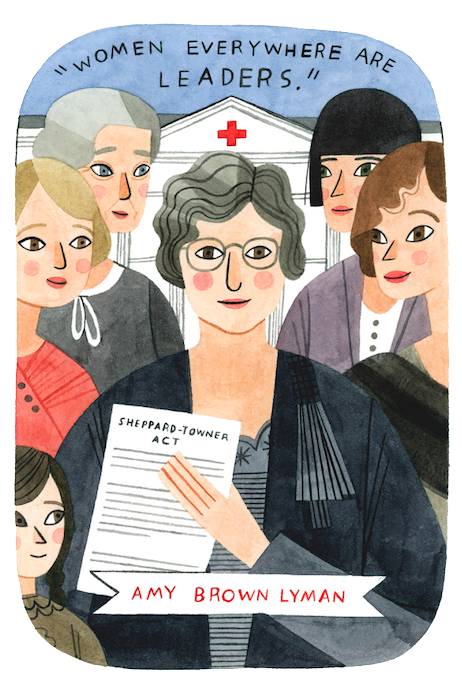
Additional Resources
Amy Brown Lyman,
A Social Worker and Leader
1872-1959
“Women everywhere are leaders.”
by Dave Hall
Amy Brown Lyman learned about tragedy at an early age. Born in 1872 in what was then the tiny village of Pleasant Grove, when Amy was eleven, her seven-year-old brother died of a burst appendix. In an era before mass vaccination, a diphtheria epidemic raged through her town, taking the lives of several neighboring children. When Amy was a little older, a half-sister died of infection following childbirth. Meanwhile, Amy’s mother spent half her life disabled due to inadequate care during her last two pregnancies. Such tragedies were not unusual at the time, but as Amy became a young adult, advancements in medical knowledge meant that they could now be prevented. Like many women of her generation, Amy therefore grew interested in finding ways to spare others the hardship she had witnessed. Opportunities soon came allowing her to do so.

Amy Brown Lyman as a faculty member at Brigham Young Academy in the 1890s. Courtesy of Utah State Historical Society.
Amy married in 1896 and moved to Salt Lake City, where she was invited to join a club of prominent women involved in study and community improvement. These associations would eventually lead her to important opportunities for service, but first, in 1902 she traveled east when her husband, a professor at the University of Utah, pursued graduate study. A stop along the way at the University of Chicago allowed Amy to take a course on the relatively new subject of sociology. An assignment led her to the famous social settlement of Hull House where she met and interviewed its influential founder Jane Addams. At Hull House, Amy saw practical methods of social work used to help members of disadvantaged communities overcome the problems they faced. She later said that her experience was like watching a curtain opening in her mind, revealing new ways to help people in need.

Amy Brown Lyman in 1914 about the time she began her involvement in Relief Society social work. Courtesy of Church History Library.
Soon after her return to Salt Lake, Amy was invited to become a member of the leadership of the National Women’s Relief Society of the Mormon Church. Because of her interest in social work, she soon joined committees aimed at improving the charity activities of the church. By 1913, the Relief Society was providing fresh milk during the hot summer months to mothers of young children in Salt Lake’s poorer neighborhoods, as well as employing a nurse to provide medical care and assistance. When the United States entered World War I, Amy was trained by the Red Cross to provide aid to Latter-day Saint members of the military and their families. Using these same principles, she established a social welfare department in the Relief Society after the war to help families with relationship and economic problems. She also began a program to train thousands of Relief Society women in the basics of social work so they could help individuals in their own communities.
In 1921 Congress passed a measure known as the Sheppard-Towner Act to save the lives of mothers and children by educating women about health and nutrition. It also aided states in establishing clinics where mothers and young children could be examined for health problems. Amy immediately saw the value in this program and with the full support of other Relief Society leaders, she worked tirelessly to help carry it out–even winning election to the Utah legislature to help pass a law allowing the state to participate. Amy then organized Relief Society women into a virtual army in support of the Sheppard-Towner work. National officials gave credit to the Relief Society for saving hundreds of lives of expectant mothers and young children.

Amy Brown Lyman. Courtesy of Utah State Historical Society.
At the end of the 1920s, Amy also organized Relief Society women to lobby the Utah legislature to create a special school to train mentally challenged individuals to live independent lives in their communities. The resulting institution was established in American Fork. When the Great Depression hit, Amy remained active in social work activities in the church and cooperated with federal officials to bring needed aid to Utah. In 1940 she became president of the Relief Society herself, and organized Relief Society women to help individuals and families during the difficult years of World War II. Released from her responsibilities in 1945, she remained interested and involved in community affairs until her death in 1959.
Amy Brown Lyman lived a life of service, one filled with real importance and meaning. Looking back on her activities she could take satisfaction in knowing that she had helped countless numbers of women and their families avoid the kinds of tragedies she had witnessed as a child.
Dave Hall is the author of A Faded Legacy: Amy Brown Lyman and Mormon Women’s Activism, 1872-1959.

